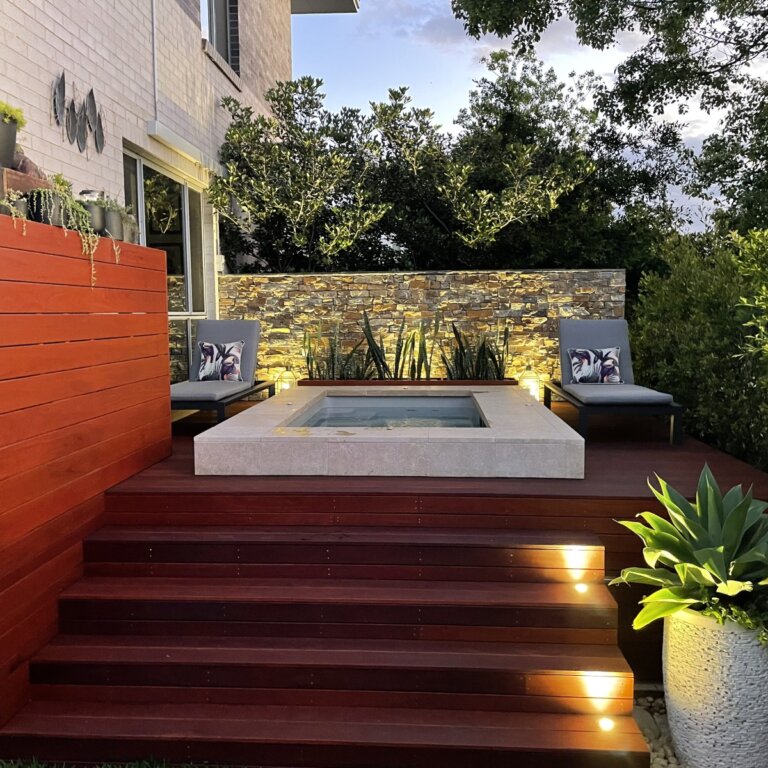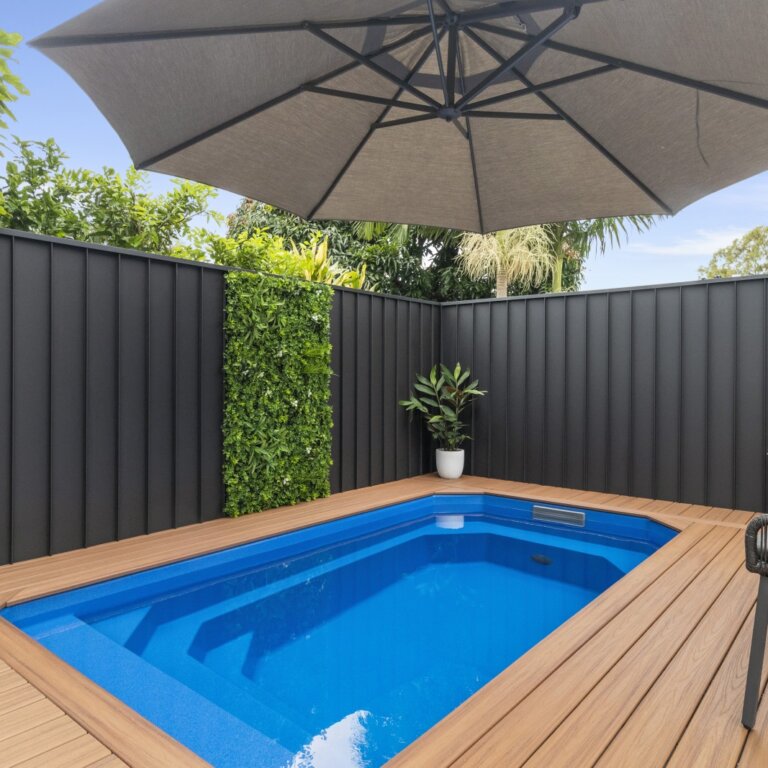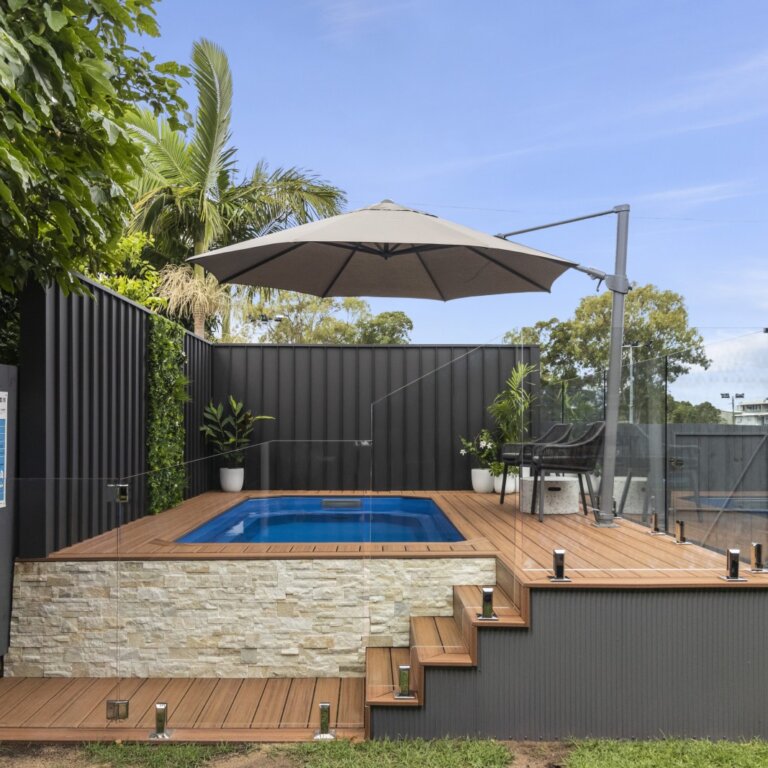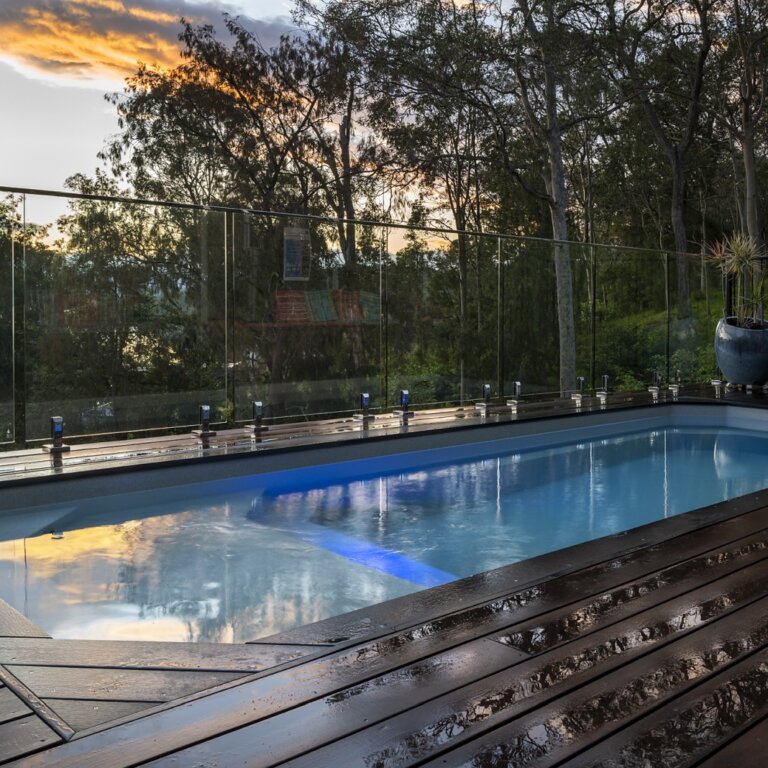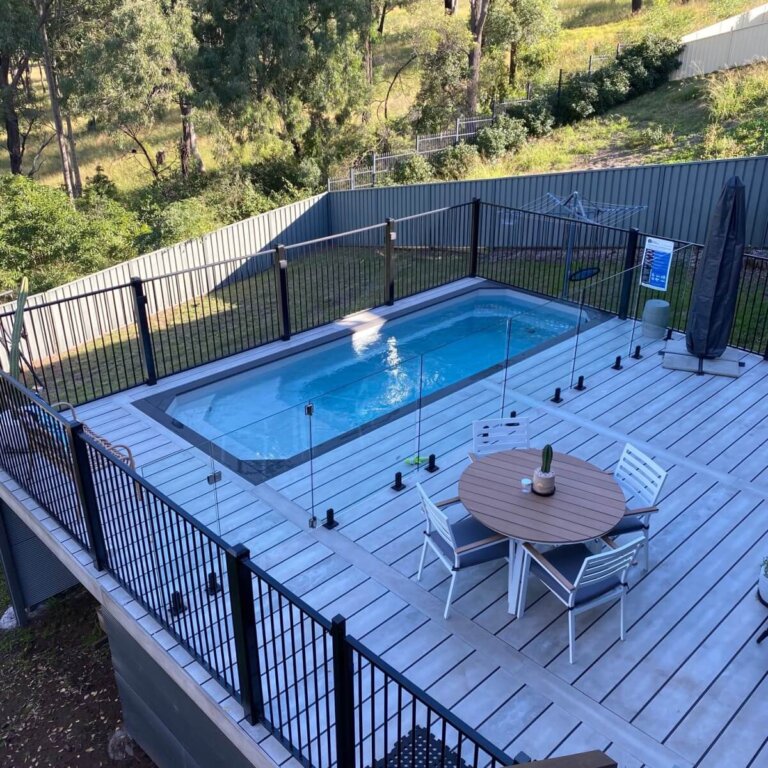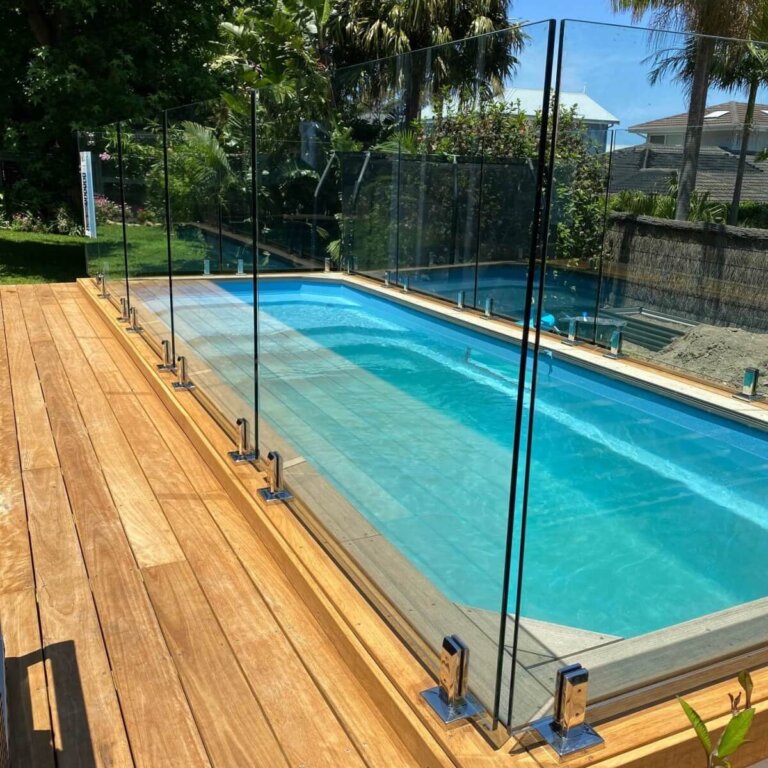One of the biggest modern pool trends is moving away from large extravagant pools that take up a huge chunk of real estate towards smaller plunge pools.
Even if you have a smaller modern-style home and backyard, there’s probably space for a pool, particularly if you choose one of the compact and convenient prefab plunge pools on the market. Two of the most popular options for this type of pool are a precast concrete plunge pool and fiberglass freestanding plunge pools.
Pre-manufactured swimming pools offer a huge advantage over in-ground built on-site options. They allow you to go from an empty backyard to glistening cool in a fraction of the time it would take to build one. So while you might be struggling to decide what kind of pre-manufactured pool you plan to install, we can all agree that there is the quickest and easiest way to add a swimming pool to your South Carolina backyard.
If you’re shopping for a pool for your family in South Carolina, and you’re not sure which option is for you, you’re in the right place. Let’s take a look at both of these options and how they compare.
What Are Precast Concrete Plunge Pools?
Before we get into the head-to-head between precast concrete plunge pools and fiberglass freestanding plunge pools, it’s a good idea to know what each of them is, starting with precast concrete plunge pools.
As the name suggests, precast concrete plunge pools our pools that are manufactured from concrete in a factory rather than being cast in place on-site.
This is done by building molds or forms around a central steel reinforcement structure and then carefully filling the forms with concrete. Manufacturers have to be careful to choose the right type of concrete and to prepare and pour it very carefully to ensure the finished result is strong and free of voids and weak spots. So it’s a little more complex than it sounds!
This means that they can be installed above ground rather than as an inground pool, and there’s no excavation formwork or general construction chaos to deal with. They are just as strong as traditional concrete pools, though, and they still have built-in steel reinforcement. So you can be sure you’re getting a pool that will stand the test of time.
What Are Fiberglass Freestanding Plunge Pools?
The other option we’re looking at in this article is fiberglass freestanding plunge pools.
Like precast concrete plunge pools, there manufactured off-site in a factory using glass fiber and various resins and chemicals; precast concrete plunge pools that can also be manufactured in a huge variety of shapes, plus they offer a rainbow of color options and more.
Fiberglass is usually laid in layers over a mold or form, allowing the manufacturer to build up many layers of waterproof, mold-proof, ultra-strong, and extra-light material.
Once the structure itself is created this way, the final layers of the manufacturing process will usually include any decorative elements and special pigments.
However, fiberglass doesn’t have the rigidity and strength that precast concrete does, so while these pools can also be installed as above-ground pools, they do require additional support structures.
Concrete Vs. Fiberglass: Strength and Durability
The first thing we need to compare in the battle of concrete versus fiberglass is the strength and durability of a precast plunge pool made of concrete and one manufactured from fiberglass. Let’s start with concrete.
There’s a reason why Roman ruins built of concrete are still standing today. It’s the same reason why bomb shelters, breakwaters, and airport landing strips are made from concrete. Once dry, and assuming you’ve used the correct mixed design, concrete is one of the strongest man-made substances in the world.
Concrete is virtually impervious to weather, it doesn’t corrode, and it has a lifespan that’s measured in decades. Concrete plunge pools are usually lined with a different substance, which will usually wear out long before the pool structure shows any signs of wear. However, even then, we’re talking about a typical life span of 10 to 15 years.
The strength and durability of fiberglass prefab plunge pools vary enormously based on the materials and designs used to create them. However, a high-quality fiberglass plunge pool that is made with the correct materials that are UV resistant and properly reinforced will easily last for a 25-year warranty.
So when you’re comparing concrete precast plunge pools and fiberglass prefab plunge pools, it really comes down to the manufacturer’s attention to detail.
Concrete Vs. Fiberglass: Design and Esthetics
The next big thing we need to compare between a concrete plunge pool and fiberglass prefab plunge pools are design and aesthetic options. In this case, the two options are very different.
On the one hand, prefab concrete plunge pools have a chunkier, almost industrial appearance that also lends itself to design features like exposed aggregate decorative tile and mosaics, and on the other, there’s the sleek modern design of fiberglass prefab plunge pools.
You can’t really compare the two because they are very different, but because each offers so many design options, there’s a style to suit every taste.
The good news about design is that we’ve come a long way in swimming pool design over the years, so there are some fantastic options available. You’ll never have to settle for boring grey concrete or plain white fiberglass, no matter what you choose!
Fiberglass pools from The Little Pool Co look stunning in South Carolina backyards. Check out some of their installations:
Pool Works are proudly installed above ground fiberglass pools from The Little Pool Co. Check out our Plunge and Relax pool range.
Concrete Vs. Fiberglass: Optional Extras
The good news, if you’re struggling to decide between concrete and fiberglass plunge pools, is that most of the optional extras available are available for both types of pools.
That means that no matter which option you choose, you can still add a lounging deck, poolside seating options, water jets, designer lighting, slides, diving boards, and more.
That’s great news because we all know that the perfect pool is more than just a container for water. It’s a place to enjoy the South Carolina sunshine with your family and friends. It’s the place where you swim laps to get fit. It’s the place where your kids enjoy their first splashes and where your grandkids discover older swimming pool games you played as a child.
You could even say that it’s the optional extras that make all the difference.
Concrete Vs. Fiberglass: Installation Options
The next big thing you might want to know when comparing prefab concrete plunge pools to their fiberglass cousins is what your installation options are.
Thanks to the fantastic weather in South Carolina, we don’t have to deal with problems like frost heave. So we can install our swimming pools in the ground, partially in-ground or above ground as we see fit. There’s no special engineering required to install your Low Country swimming pool in any of these ways.
The good news is that high-quality concrete plunge pools and well-manufactured and well-designed fiberglass plunge pools can both be installed in any of these ways.
There may be some changes to the design of the pool, however, so when you are discussing your options and placing your order, make sure your pool company knows how you plan to install your pool.
Concrete Vs. Fiberglass: Freight and Installation Costs
When it comes to freight and installation costs, There is a clear winner in the battle between concrete and fiberglass.
Because precast concrete plunge pools a significantly heavier than fiberglass prefab plunge pools, you can typically expect to pay more for shipping and installation.
Not only will it be more difficult to load and transport a concrete plunge pool, but it’s very likely that you will need a heavy-duty crane to move it into position. It’s also much more difficult to make minor adjustments to the position during the installation process, and there’s a significant element of danger during the process.
Fiberglass prefab plunge pools, by comparison, weigh a fraction of what their concrete counterparts do. This means that the cost and difficulty of shipping them to the site will be much lower, and the equipment required to install them will be simpler and cheaper.
Precast concrete plunge pools typically require more specialized equipment to install, and they usually require more skilled people. This also increases the cost of installing this type of pool.
Concrete Vs. Fiberglass: Ground Preparation
When it comes to installation costs in the concrete versus fiberglass pool battle, there’s another important factor to consider. That is ground preparation.
Because concrete pools are themselves significantly heavier than fiberglass pools, once they are filled with water, they will put enormous pressure on the ground below. Because of this, there’s a good chance that you might need to do density testing or compaction before you can install a concrete plunge pool.
That’s not to say that you wouldn’t need to do ground preparation with a fiberglass pool, but they are much lighter and can even be installed on existing concrete pads or concrete rooftops. Try doing that with a 20,000-pound concrete pool.
Concrete Vs. Fiberglass: Maintenance and Repairs
You might think, given the outstanding durability of concrete, that they’re a low-maintenance pool option. However, that is incorrect.
Because precast plunge pools have to be lined with other substances ranging from plaster two vinyl and other materials, there’s a lot more maintenance required for this coating layer. You will need to spend extra time and pay more attention to preventing algae growth, sun damage, and mechanical damage to the surface.
It’s also more difficult and costly to repair these kinds of surfaces when something does go wrong. They also tend to stain more easily, so if algae do take hold in your pool, you might be facing serious repair costs.
Fiberglass prefab plunge pools, on the other hand, are designed with a smooth and easy-to-maintain surface. It’s designed to be easy to clean, UV resistant, and resistant to scratches and chips.
Even when the surface of a fiberglass pool is damaged, the repair process is generally quicker, easier, and cheaper.
Concrete Vs. Fiberglass: Demolition and Removal
No one wants to think about demolition when they’re planning a pool installation. However, no matter how robust the pool you choose is, at some point in the future, someone will need to remove and replace the pool.
Maybe that’s something future owners of your home will have to worry about, but if you do ever decide to build an addition, change the design of your backyard, or install a different pool, it is something you will need to deal with.
When it comes to demolition and removal, precast pools suffer from the same problem they have during freight and installation; that is, they are incredibly heavy. They are also incredibly durable, which is good news when you want to pool that will last, but not when you want to remove one.
Precast concrete pools will need to be broken up with jackhammers, cut with angle grinders, and loaded into heavy-duty bins for disposal; because of the weight of the material, you can expect to pay high transport costs from your home to the dump.
Fiberglass prefab plunge pools, by comparison, are much easier to demolish and remove should you ever need to. Once the water is drained from the pool, it’s a relatively easy task to cut the pool into manage manageable pieces, and the cost to transport it to the dump will be significantly lower.
Concrete Vs. Fiberglass: Cost
Another big factor for most people trying to choose between precast pools and fiberglass pools is cost.
Generally speaking, for a pool that is the same size and holds the same amount of water, the fiberglass option will be significantly cheaper.
That’s because the materials required to manufacture the pool are usually cheaper, and the cost to install a fiberglass pool will be much lower than the same size concrete pool.
Many Factors to Consider
If you arrived on this page, you’re probably looking for the best swimming pool option for your Low Country, South Carolina home.
We hope this comparison has highlighted the pros and cons of these two popular prefab plunge pool options. Even though each one has clear benefits over the other, they are both great options when done correctly. There are also several other kinds of premanufactured pools that can be installed in the ground, partially in the ground, or above ground, so you might still need to do a little more investigating.
Always ensure that no matter what kind of prefab plunge pools you are considering, quality and expertise are your top considerations. A new swimming pool is a significant investment, and it’s not one you should rush into.
Take your time to do more research, investigate the top swimming pool suppliers in South Carolina, ask as many questions as you need to, and get quotes on all the options you think will work for your home.
Pool Works is a licensed installer of The Little Pool Co. products, and we’re always happy to answer any questions you have about pool types, installation methods, costs, and more.
Whether you’re ready to get a firm quote on your new pool project or you’re just collecting brochures and scribbling down ideas, our team is always ready to help.


